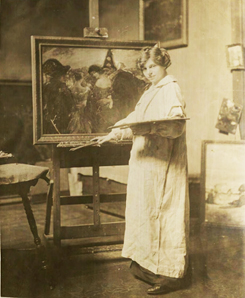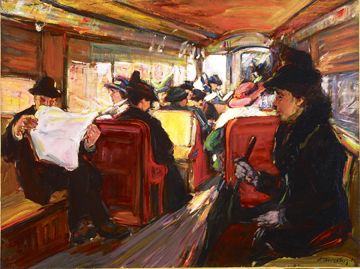Art Essay: Transported to the Public Sphere:
Theresa Bernstein and “In the Elevated”
By Rena Tobey ©2015
ART TIMES Summer 2015
 Theresa Bernstein at her easel with the lost painting “Moonlight Masquerade”, 1915. Photo as reproduced in Gail Levin, ed., Theresa Bernstein: A Century in Art and the related website. |
In the early 1900s, the emerging New Woman artist began to depict her world in bold ways, distinct from her predecessors. While benefitting from the breakthroughs of preceding generations, these modern women asserted their professional identities and demanded the same kind of recognition as their male colleagues. Theresa Bernstein (1890–2002) typified this New Woman artist. Although she was white and middle class, as a child of Jewish immigrants, her background diverged from the traditional ideals of the 1800s Protestant True Woman. She pushed out of the private sphere of home and family to embrace an increasingly urban, modern culture. She reflected the vital women’s issues of her day in paint, through visual representations of women’s lives, priorities, values, and politics.
With an art career that lasted over ninety years and spanned the 20th century, Bernstein had a passion for depicting scenes of everyday life. Early in her career, in the 1910s, she was informally associated with the Urban Realist movement, known as The Eight or the Ashcan School. Although not a school, this association of eight men, led by the charismatic Robert Henri (1865-1929), changed American art from bright Impressionist depictions to grittier scenes of urban reality. Before moving to New York, these male artists worked as newspaper illustrators in Philadelphia. Bernstein was born and trained as an artist in Philadelphia, so was also steeped in city life. She studied at the Philadelphia School of Design for Women, where acceptable modes of art for the female, such as printmaking and industrial design, were taught. With her parents’ support, Bernstein moved to New York in 1912, four years after the breakthrough exhibit of The Eight there.
She shared their sensibility and style and was mistakenly considered one of Henri’s students and as part of the group. Neither was the case. Bernstein’s professional path did intersect with members of The Eight. She and her husband William Meyerowitz (1887-1981) belonged to the same artist organizations. She exhibited work with The Eight, notably at the McDowell Club in non-juried shows, a tradition that Henri started to create equal opportunity for all artists.
Like her avant-garde male colleagues, she painted what she saw and lived—the cinema, trolleys, city parks, Coney Island, political rallies, the employment office, concerts, dances, and July 4th parades—depicting people from all social strata. Between 1914 and 1916, she painted suffrage parades and meetings, including a soapbox orator in front of a crowd of women and men in a park setting, combining her interests in crowd scenes and women’s rights. Her works were often set at night, also popular among the Ashcan School artists for demonstrating technical proficiency at evoking mood and painting detail in low light.
Still, fighting the prejudice against women artists was foremost for Bernstein. Sensitive to possible discrimination, she signed her work T. Bernstein to conceal her gender, but her anonymity was short-lived. A male art club, the Salmagundi Club, withdrew an offer of membership when they discovered Bernstein was a woman. A reviewer for “The International Studio“ said she painted like a man, meaning with a vitality and virility stereotypically associated with males. The comment was a backhanded compliment, since women artists were still expected to produce gendered art, featuring subject matter reflective of the domestic sphere and a more delicate sensibility. Although she painted similar subjects as the other contemporary artists in New York and with a powerful expressionistic style, Bernstein had to carefully present her subjects with a kind of decorum that The Eight could satirize.
A good example of the differences in gendered approach came with one of her most notable paintings, In the Elevated, from 1916. It depicts a new mode of urban transportation, the elevated train, a subject showing the rapid technological and social changes so popular with Urban Realists like The Eight. In 1912, one of The Eight, John Sloan (1871-1951) depicted the Third Avenue El in Six O’Clock, Winter. The viewer is standing underneath the El, which thrusts forward across the picture plane in an aggressive, almost menacing way. Set at night, the El could be a monster, impersonal and looming over the crowd.
 Theresa F. Bernstein,“ In the Elevated”, 1916 Oil on canvas, 30 x 40 in. The Fine Arts Museums of San Francisco, Museum purchase, American Art Trust Fund, 2011.2 • |
Unlike Sloan, Bernstein takes the viewer inside the elevated car in bright daylight, right on the seat by the other passengers. Even with the vivid colors and restless motion of choppy diagonal lines that move the eye all over the canvas, the scene is innocent compared to Sloan’s El. In Bernstein’s train, at this relatively quiet time, likely non-rush hour, the viewer may study the scene—not as the voyeur Sloan likes to make of the viewer, but as a participant. Immediately in front is a woman in profile, holding her umbrella, perhaps ready to take on the traditional woman’s role as consumer. She sits quietly and primly, with an aura of respectability. She carefully avoids making eye contact, an etiquette already formed for mass transit.
The fact that a well dressed, middle-class woman travels alone is a significant demonstration of change for women and their lifestyles. Granted, she would not have ridden Sloan’s El late at night. But now, women were moving out of the private sphere for more than shopping. Privileged women used their leisure time for social and civic betterment, as part of women’s clubs. The National Women’s Party organized women to campaign and protest for suffrage, which after almost 75 years of advocacy was accomplished with the 19th Amendment in 1920. Many women were entering the workplace in newly proliferating clerical jobs. Bernstein herself regularly rode the Columbus Avenue El to her studio. The viewer can ponder where each of these passengers is going.
In the Elevated also suggests another modern agenda. Two women passengers, highlighted by sun streaming in the windows, look out at the passing worldview. Their act of looking is powerful, no longer solely the prerogative of men. These New Women also know they are not invisible. They are aware of looking and being looked at, presenting themselves for the world’s view. They are brightly lit and in such great numbers that their facial features, formed by rapid, rough brushstrokes, blur.
With these hard-to-read figures, the anonymity on Bernstein’s El becomes sociological. The Separate Spheres are breaking down, as women readily travel on their own to enter the greater world beyond the domestic. The transitional venue of the train, the technology that connects the private and business spheres, is alive with color, energy, and verve. The diagonal lines of the train converge toward the front, emphasizing the rapid-forward motion. Women are moving toward emancipation with the force and thrust of the masculine progress long associated with the railroad. A critic in the “New York Evening Sun” wrote about In the Elevated, “Theresa Bernstein has brought travelling humanity in New York home to the consciousness.” Society was absorbing the implications of women’s movement toward increased rights and freedoms.
Still, this El is gendered. A man, one of only two on the train, reads a newspaper—that masculine emblem of the public sphere of commerce and politics. He is rendered with as much prominence as the woman in the foreground.
In addition to social commentary, Bernstein also created a kind of personal portrait. The woman closest to the viewer is her mother, wearing that distinctive hat featured in a later photograph, and her father reads the news. These recognizable models convert the painting into an intimate look at her private domain. The viewer can even imagine the figures in these same poses in their sitting room at home. By bringing in detailed depictions, Bernstein invites the viewer to speculate on their thoughts. The experience of Bernstein’s El, in contrast to Sloan’s, invites this personal engagement, an intimate empathy with another’s experience. How has the El changed the world for these two riders? On the El, the psychological can meet the sociological; the viewer can access the personal, as it moves into the world.
In 1919, Bernstein’s artistic world opened further, when she married Meyerowitz, a fellow artist and Russian immigrant. He helped open doors to the avant-garde art world. While Bernstein maintained her art style independence, confident expression, and maiden name, she also championed his work. She painted portraits of and wrote poems about Meyerowitz. The couple enjoyed a supportive, collegial professional life, including teaching together. However, their companionate marriage did involve compromise. Like so many other women in artist couples, Bernstein put his career before her own. Just as the individual woman artist had to navigate the professional art world with socially acceptable women’s roles, so too did the artist-wife have to negotiate a place in her marriage. Power politics entered the private sphere in ways that are still relevant today, in any two-career household.
This essay is the fifth from the "Finding Her Way" series, exploring the challenges American women artists faced from about 1850 to 1950.
Elizabeth Okie Paxton Summer 2014
Lilly Martin Spencer Fall 2014
Alice Barber Stephens Winter 2014
Marie Danford Page Spring 2015
• Warning: All rights reserved. Unauthorized public performance, broadcasting, transmission, or copying, mechanical or electronic, is a violation of applicable laws. This product and the individual images contained within are protected under the laws of the United States and other countries. Unauthorized duplication, distribution, transmission, or exhibition of the whole or of any part therein may result in civil liability and criminal prosecution. The downloading of images is not permitted. © Fine Arts Museums of San Francisco.
